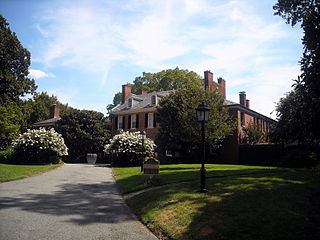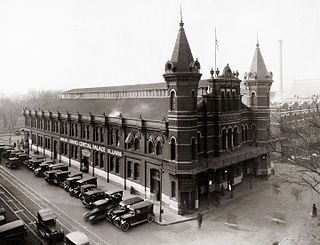
Pennsylvania Avenue is a primarily diagonal street in Washington, D.C. that connects the United States Capitol with the White House and then crosses northwest Washington, D.C. to Georgetown. Traveling through southeast Washington from the Capitol, it enters Prince George's County, Maryland, and becomes MD Route 4 and then MD Route 717 in Upper Marlboro, and finally Stephanie Roper Highway.

Benjamin Stoddert was the first United States Secretary of the Navy from 1 May 1798 to 31 March 1801.

Robert Todd Lincoln was an American lawyer and businessman. The eldest son of President Abraham Lincoln and Mary Todd Lincoln, he was the only one of their four children to survive past the teenage years and also the only to outlive both parents. Robert Lincoln became a business lawyer and company president, and served as both United States Secretary of War (1881–1885) and the U.S. Ambassador to Great Britain (1889–1893).

Dupont Circle is a historic roundabout park and neighborhood of Washington, D.C., located in Northwest D.C. The Dupont Circle neighborhood is bounded approximately by 16th Street NW to the east, 22nd Street NW to the west, M Street NW to the south, and Florida Avenue NW to the north. Much of the neighborhood is listed on the National Register of Historic Places. However, the local government Advisory Neighborhood Commission and the Dupont Circle Historic District have slightly different boundaries.

James Hoban was an Irish-American architect, best known for designing the White House.

Embassy Row is the informal name for a section of Northwest Washington, D.C., with a high concentration of embassies, diplomatic missions, and diplomatic residences. It spans Massachusetts Avenue N.W. between 18th and 35th street, bounded by Scott Circle to the south and the United States Naval Observatory to the north; the term is often applied to nearby streets and neighborhoods that also host diplomatic buildings, such as Kalorama.

William Wilson Corcoran was an American banker, philanthropist, and art collector. He founded the Corcoran Gallery of Art in Washington, D.C.

Hildene, the Lincoln Family Home is the former summer home of Robert Todd Lincoln and his wife Mary Harlan Lincoln, located at 1005 Hildene Road in Manchester Center, Vermont.

Mary Lincoln Beckwith was a prominent descendant of Abraham Lincoln. Beckwith was the great-granddaughter and one of the last two confirmed descendants of Abraham Lincoln, along with her younger brother Robert.
Suter's Tavern, also known officially as The Fountain Inn, was a tavern located in Georgetown, which later became part of Washington, D.C., and it served as Georgetown's best-known hostelry until the emergence of several newer taverns in the 1790s.

The Strivers' Section Historic District is a historic district located in the Dupont Circle neighborhood of Washington, D.C. Strivers' Section was historically an enclave of upper-middle-class African Americans, often community leaders, in the late 19th and early 20th centuries. It takes its name from a turn-of-the-20th-century writer who described the district as "the Striver's section, a community of Negro aristocracy." The name echoes that of Strivers' Row in Harlem, a New York City historic neighborhood of black professionals. The district is roughly bounded by Swann Street and the Dupont Circle Historic District on the south, Florida Avenue and the Washington Heights Historic District on the north and west, and the Sixteenth Street Historic District on the east.

Being the site of military battles, deadly duels, assassinations, untimely deaths, and other associated tragedies, there are a number of reportedly haunted locations in Washington, D.C., the capital city of the United States.

Holt House is an historic house, located on the grounds of the National Zoo in Washington, D.C. Thought to have been built before 1814, it is one of the most important examples of early Neoclassical architecture in the city, and was one of the major houses in the new national capital when it was built. Since 1889, its caretaker has been the Smithsonian Institution. It is the oldest building under the Smithsonian's management, but has been left vacant since the 1980s.

P Street refers to four different streets within the city of Washington, D.C. The streets were named by President George Washington in 1791 as part of a general street naming program, in which east–west running streets were named alphabetically and north–south running streets numerically.

The Embassy of Argentina in Washington, D.C. is the Argentine Republic's diplomatic mission to the United States. It is located at 1600 New Hampshire Avenue, Northwest, Washington, D.C. The current Ambassador of Argentina to the USA is Jorge Argüello.

Paul Johannes Pelz was a German-American architect, best known as the main architect of the Library of Congress in Washington D.C.

Evermay is a historic Federal architecture-style house at 1623 28th Street, Northwest, Washington, D.C., in the Georgetown neighborhood. The property originally extended south to Q Street, but the other houses were divided from the property.

Mary Harlan Lincoln was the daughter of United States Senator James Harlan and the wife of Robert Todd Lincoln.

Leon Emil Dessez was an American architect in Washington, D.C. He designed public buildings in the District of Columbia, and residences there and in Maryland, and Virginia, including some of the first in Chevy Chase, Maryland, where he was the community's first resident. His D.C. work includes the 1893 conversion of the Shepherd Centennial Building into the Raleigh Hotel and the Normal School for Colored Girls (1913), designed with Snowden Ashford.

Center Market was a market hall in Washington, D.C. designed by architect Adolph Cluss which operated in Washington, DC from 1872 to 1931. The building was demolished in 1931 to be replaced by the National Archives Building. A market called Center Market had been in operation on the same block of land since 1802. In 1931, the name of Center Market was transferred over to the Northern Liberty Market located a few blocks north.




















